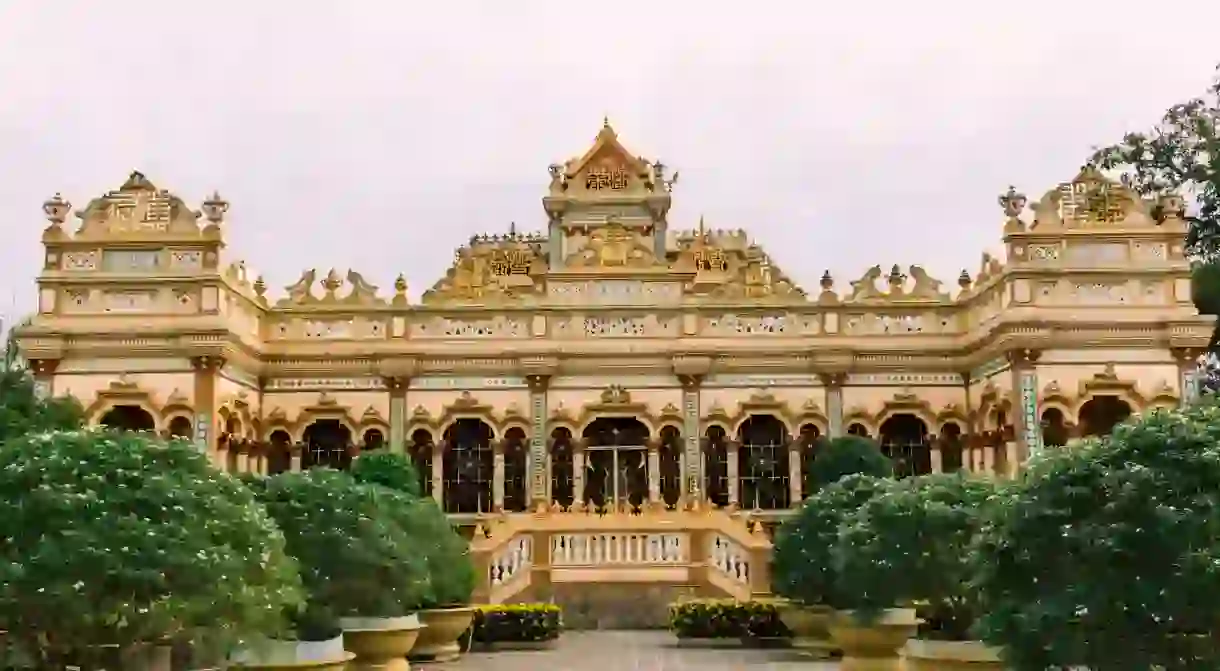Vĩnh Tràng Pagoda: Vietnam's Gorgeous Buddhist Gardens

At the heart of Vietnam’s Mekong Delta lies a gorgeous, sprawling pagoda not to be missed by visitors to this region.
The Vĩnh Tràng pagoda is one of the most well-known in the Delta and located approximately three kilometers from the center of Mỹ Tho city. Feast your eyes on this exquisite temple and surrounding ornate gardens.

About the Vĩnh Tràng temple
The sprawling pagoda rests on two acres of beautifully manicured gardens and fruit-bearing trees. The idea for the temple belonged to district chief Bùi Công Đạt in the early 19th century. After Bùi passed away, Buddhist abbot Thích Huệ Đăng presided over the rest of the temple’s construction and was the one to name it Vĩnh Tràng. The temple was completed in 1850, but just a decade later it suffered heavy damage as French colonial forces battled the Nguyễn Dynasty’s army for control of what is now southern Vietnam. Reconstruction efforts were successful, however the temple later fell into disuse.

In the late 1890s, the temple was completely renovated under the eye of new abbot Thích Chánh Hậu, only it to be heavily damaged by a powerful tropical storm. Another extensive rebuilding campaign began in 1907 under the same abbot. After his death in 1923, his successor Thích Minh Đàn organized several more renovations of the complex and oversaw the construction of the ceremonial hall and the main triple gate.

A blend of East and West
Thích Minh Đàn recruited craftsmen from the imperial city of Huế to construct the temple’s main triple gate. The center of the gate is made of steel while the gates on either side are constructed of concrete and were made to resemble a fortress. The Vĩnh Tràng pagoda’s style is an elegant blend of East and West; Renaissance-style patterns and Romanesque arches blend seamlessly with Japanese tile and traditional Vietnamese architectural styles.

The triple gate also features a second level that honours two of the pagoda’s former abbots, who oversaw much of its development. On the left is a statue of Thích Chánh Hậu while the statue on the right is of Thích Minh Đàn.

The Vĩnh Tràng pagoda features three enormous Buddha statues. The standing Buddha represents Amitabha Buddha, who symbolizes ultimate bliss and compassion. The Laughing Buddha symbolizes happiness and good luck and has become a deity for good fortune around the world. The reclining Buddha represents Gautama Buddha before he enters parinirvana, the death of one who has attained nirvana during his lifetime and has been released from the painful cycle of samsara, or rebirth.


Precious relics and design
The pagoda is comprised of five separate buildings, two ornamental courtyards, and 178 intricately designed pillars. The temple is home to over 60 precious statues made of copper, wood, and terracotta. Among the most cherished relics are 18 arhats (Buddhist followers who have attained nirvana) carved in 1907 out of wood from a jackfruit tree. There is also a bronze bell on the property that was cast in 1854.

The main hall is adorned with multiple statues of different Buddhas as well as a statue of the Jade Emperor standing as tall as a human man. The side gates are decorated with colourful porcelain mosaics depicting Buddhist stories.

The pagoda is framed by beautifully manicured gardens, fruit-bearing trees and bonsai trees that make for a peaceful atmosphere. The scent of incense perfumes the air and monks stroll around the grounds, ensuring the property is kept in excellent condition. Past monks who cared for the pagoda were laid to rest inside the grounds and their graves are decorated with engraved stones.

1850 to 2018
The Vĩnh Tràng pagoda was recognized by the Vietnamese government as a national historical and cultural relic in 1984 and is one of the Mekong Delta’s biggest tourist attractions today. The soft pastel colours of the buildings contrast beautifully with the bright blue sky, but if you happen to visit on a rainy day the mist adds an enchanting quality to the temple. Whether rain of shine, the Vĩnh Tràng pagoda is a must-see for travelers to the Mekong Delta.


Today, the monks who maintain the pagoda also run a home for children with disabilities, orphans, and other children in need.

Did you know – Culture Trip now does bookable, small-group trips? Pick from authentic, immersive Epic Trips, compact and action-packed Mini Trips and sparkling, expansive Sailing Trips.













